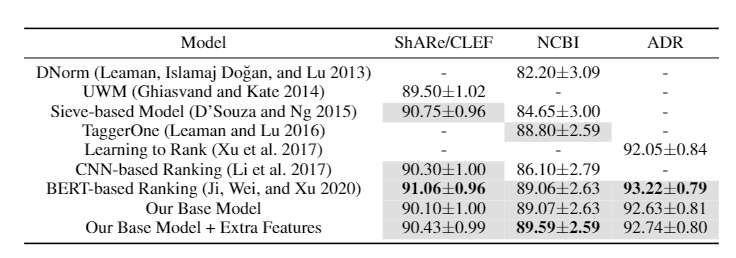This is a Keras implementation of the paper A Lightweight Neural Model for Biomedical Entity Linking.

Clone the repository and set up the environment via "requirements.txt". Here we use python3.6.
pip install -r requirements.txt
Dataset. It is not easy to collect all related data quickly. For your convenience, we provide a preprocessed version of datasets so that you could run our model straight. But there is a data license of the ShARe/CLEF dataset, we suggest you to obtain it according to an official guideline. We valid our model on three datasets, ShARe/CLEF, NCBI and ADR. Download these dataset and their corresponding knowledge bases following the urls below.
| Dataset | Reference KB |
|---|---|
| NCBI disease | MEDIC (July 6, 2012) |
| ShARe/CLEF eHealth 2013 Challenge | SNOMED-CT (UMLS 2012AA) |
| TAC 2017 ADR | MedDRA (18.1) |
Word Embedding.
In our experiments, we represent each word by a 200-dimensional word embedding computed on PubMed and
MIMIC-III corpus, which is proposed in this paper[1]. Downlaod.
After downloading, put the embedding file in the path Biomedical-Entity-Linking/input/
Entity Embedding.
We provide pre-trained entity embeddings. You can find them in this path Biomedical-Entity-Linking/output/*dataset name*/embed/entity_emb_50.txt
Certain entities are more likely to occur together
in the same document than others, and we can leverage
this disposition to help the entity linking. To capture the
co-occurrence of entities, we pre-train entity embeddings in
such a way that entities that often co-occur together have
a similar distributed representation. We train these embeddings
with Word2Vec on a collection
of PubMed abstracts2. Since the entities in this corpus are
not linked to our KB, we consider every occurrence of an
exact entity name as a mention of that entity.
Here, the medical corpus we adopt is a collection of PubMed abstracts
which can be obtained at ftp://ftp.ncbi.nlm.nih.gov/pubmed/baseline/
First you can use -help to show the arguments
python train.py -help
Once completing the data preparation and environment setup, we can evaluate the model via train.py.
We have also provided datasets after preprocessing, you can just run the mode without downloading.
python3 train.py -dataset ncbi
Using Optimal Parameters
- NCBI datast
python train.py -dataset ncbi
- ShARe/CLEF dataset
python train.py -dataset clef -hinge 0.30 -alpha 0.6
- ADR dataset
python train.py -dataset adr
Adding Features
- add prior
python train.py -dataset ncbi -add_prior True
- add context
python train.py -dataset ncbi -add_context True
- add coherence
python train.py -dataset ncbi -add_coherence True -voting_k 10
-voting_k 8 for ncbi
-voting_k 10 for adr
-voting_k 15 for ShARe/CLEF
@inproceedings{chen2021lightweight,
title={A Lightweight Neural Model for Biomedical Entity Linking},
author={Chen, Lihu and Varoquaux, Ga{\"e}l and Suchanek, Fabian},
booktitle={The Thirty-Fifth AAAI Conference on Artificial Intelligence},
number={35},
pages={14},
year={2021}
}
[1] Zhang Y, Chen Q, Yang Z, Lin H, Lu Z. BioWordVec, improving biomedical word embeddings with subword information and MeSH. Scientific Data. 2019.
